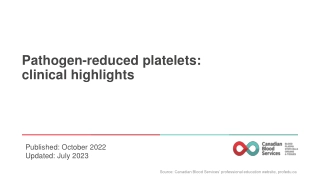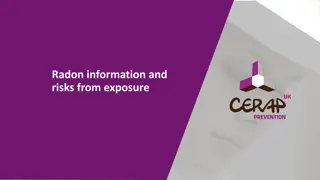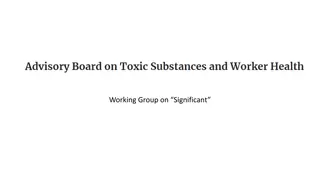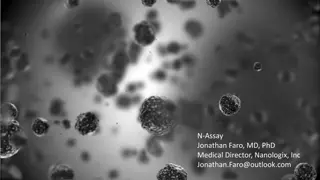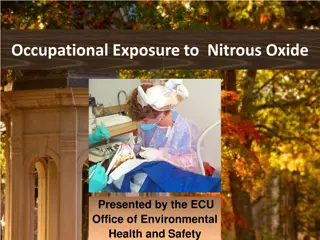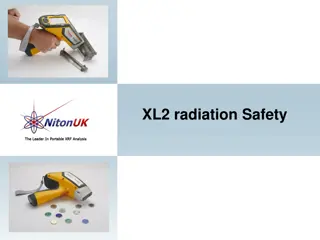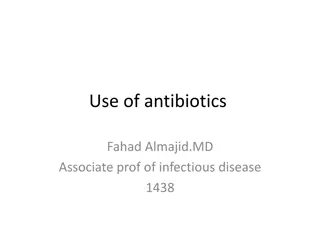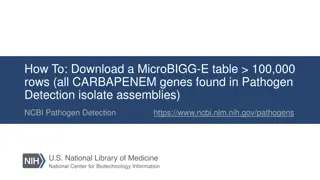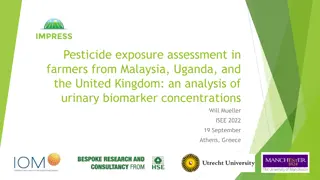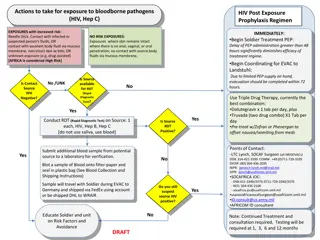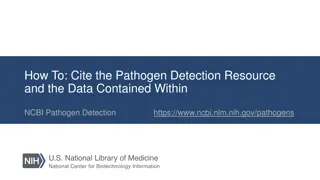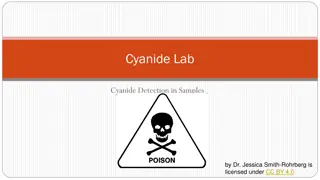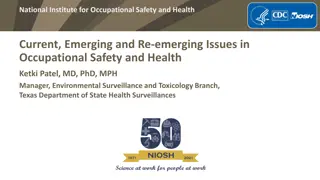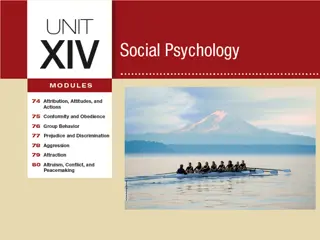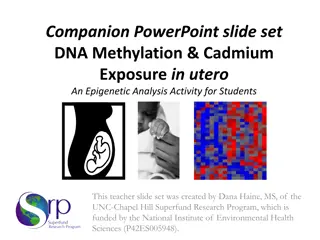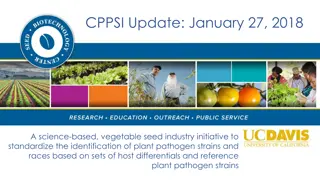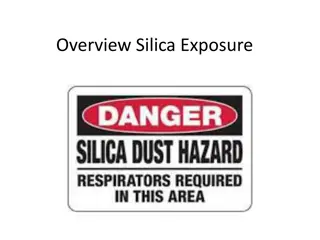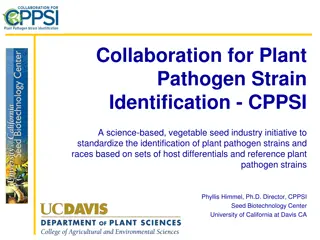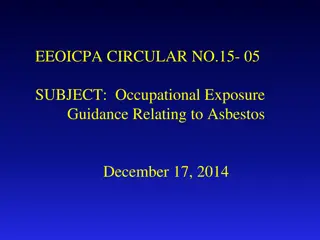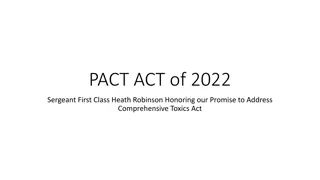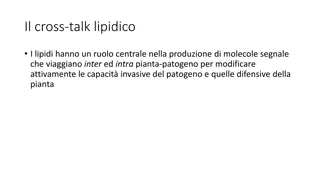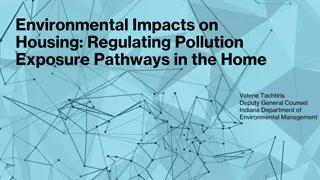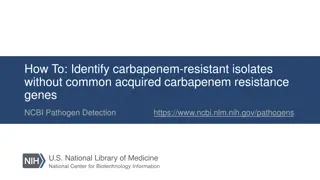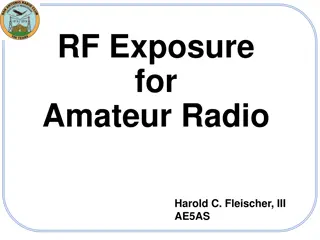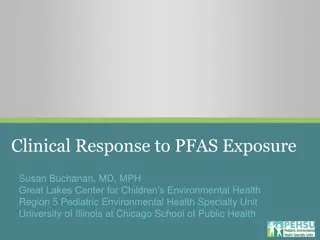Pathogen-reduced platelets: clinical highlights
Pathogen-reduced platelets play a crucial role in reducing the risk of transfusion-transmitted infections through pathogen inactivation technology (PIT). This technology provides an additional layer of safety against various pathogens including viruses, bacteria, protozoa, and leukocytes. Platelet c
2 views • 17 slides
Impact of NVIDIA Stock Surge on Mutual Funds and Passive Funds Exposure
NVIDIA's stock surged by 16% following strong financial performance, impacting various mutual funds and passive funds. Mutual funds like Motilal Oswal, Mirae, and Franklin have significant exposure to NVIDIA, while non-broad-based passive funds also hold substantial positions. The exposure of broad-
4 views • 10 slides
Update on Pathogen Reduction of Platelets at National Haemovigilance Conference 2023
This update covers the latest developments in pathogen reduction of platelets, including the introduction of whole blood containing platelets. Key strategic initiatives focus on assessing post-collection blood product manipulation processes and developing new products to meet healthcare needs. The a
0 views • 25 slides
Credit Finance Sub-Group and NPRR Updates
Updates from the Credit Finance Sub-Group include discussions on operational NPRRs, new invoice reports, EAL changes, and DC Energy's exposure calculations. The group considered improvements in credit implications, concentration limits, and more. NPRR 1186 was reviewed for enhancements to ESR monito
0 views • 12 slides
Understanding Radon Exposure Risks and Prevention Measures
Radon is a colorless, odorless radioactive gas present in rocks and soils. It can enter buildings through cracks and pipes, posing health risks like lung cancer. Exposure to radon can lead to radiation damage to cells and increase the risk of cancer. It's essential to be aware of radon levels in ind
1 views • 14 slides
Understanding NHANES Data for Environmental Exposure Studies
National Health and Nutrition Examination Survey (NHANES) is a crucial population-based survey in the U.S. that collects data on health and nutritional status. This data supports various applications, including assessing human exposure to environmental chemicals. NHANES conducts biomonitoring to qua
5 views • 27 slides
Occupational Heat Exposure Control and Prevention Practices
Occupational Heat Exposure Control and Prevention Practices at the New Mexico Institute of Mining and Technology covers training for workers exposed to excessive heat, pre-test evaluation, objectives focusing on heat stress and exposure, understanding heat and heat stress, human body's response to h
1 views • 37 slides
Understanding Phytophthora: Destructive Plant Pathogen
Phytophthora is a destructive plant pathogen that infects various crops, causing symptoms like leaf lesions and rotting tubers. Its somatic structure includes profusely branched hyphae, and it reproduces asexually through zoospores. The germination process involves the spread of spores by wind and w
1 views • 21 slides
Understanding the Significance of Exposure in EEOICPA Procedures
Delve into the complexities of exposure assessment in the context of EEOICPA procedures, examining the nuances of significant exposure levels and their impact on causation determination. Explore proposed recommendations for refining exposure assessment metrics to enhance causation evaluation.
0 views • 9 slides
Revolutionary N-Assay: Transforming Pathogen Detection in Healthcare
Innovative N-Assay developed by Jonathan Faro, MD, PhD, offers a faster, more accurate, and cost-effective solution for detecting bacterial pathogens in healthcare settings. Unlike traditional assays, N-Assay differentiates between viable and non-viable pathogens, provides information on antibiotic
1 views • 15 slides
Understanding Salmonella: A Zoonotic Pathogen
Salmonella, a genus of bacteria, includes species causing various diseases in humans, cattle, sheep, goats, and poultry. The pathogen can be transmitted through contaminated food and is classified into typhoidal and nontyphoidal serovars. Nontyphoidal serovars are common and typically lead to self-l
0 views • 20 slides
Nitrous Oxide Occupational Exposure Guidelines and Monitoring
This information covers the occupational exposure to nitrous oxide, including its uses, chemical description, routes of exposure, health effects, monitoring methods, and regulatory exposure limits. Nitrous oxide is a colorless gas with various applications in medical, dental, and food processing ind
2 views • 18 slides
Understanding Radiation Safety for XL2 Analyzers
The Niton Model XL2 analyzer uses an X-ray tube that emits radiation when turned on, requiring adherence to the ALARA principle to minimize exposure. Factors like time, distance, and shielding play crucial roles in managing radiation exposure. Learn how to stay safe while using the XL2 analyzer to e
0 views • 11 slides
Understanding Occupational Exposure to Formaldehyde
Occupational exposure to formaldehyde is common in various industries and settings, including medical laboratories and mortuaries. Formaldehyde is used as a preservative, embalming agent, and in the manufacture of various products. It poses health risks through inhalation and skin exposure, potentia
0 views • 14 slides
Best Practices for Antibiotic Use in Infectious Diseases Management
Antibiotics play a crucial role in preventing and treating diseases, but misuse and overprescription are common issues. Dr. Fahad Almajid emphasizes the importance of accurate diagnosis, host factors consideration, and microbiology testing for effective treatment. Identifying life-threatening infect
0 views • 51 slides
How to Download a MicroBIGG-E Table with >100,000 Rows from NCBI Pathogen Detection
Learn how to download a MicroBIGG-E table containing all CARBAPENEM genes found in Pathogen Detection isolate assemblies on NCBI. Follow a step-by-step guide to select, filter, and download subsets of data in batches to get the complete dataset.
0 views • 10 slides
Enhancing Pesticide Exposure Assessment for Epidemiological Studies
Focuses on IMPRESS project aiming to improve methodologies for assessing occupational pesticide exposure in epidemiological studies. Reviews challenges in retrospective exposure assessment, proposes methodologies, and presents key project results to date, emphasizing the use of various exposure asse
1 views • 15 slides
Pesticide Exposure Assessment in Farmers from Malaysia, Uganda, and the United Kingdom
This study evaluates the impact of pesticide exposure on farmers' health in Malaysia, Uganda, and the UK using urinary biomarker concentrations. Multiple cohorts are analyzed to assess associations between exposure-modifying factors and urine metabolite measurements. The IMPRESS project focuses on i
0 views • 12 slides
Understanding Personal Exposure to Polybrominated Diphenyl Ethers (PBDEs)
This presentation explores the exposure of individuals to PBDEs in residential indoor air, highlighting the background, commercial uses, exposure pathways, and previous studies on PBDEs. It discusses the objectives, methods, results, and conclusions of a study aiming to quantify indoor air exposure
0 views • 22 slides
Photography Basics: Understanding Camera Exposure and Metering
Explore the fundamentals of camera exposure, including aperture, shutter speed, ISO, and metering modes. Learn how to control exposure settings, utilize different metering modes, and troubleshoot common exposure issues to enhance your photography skills.
0 views • 15 slides
Bloodborne Pathogens Exposure: HIV Post Exposure Prophylaxis Regimen
Take immediate action for exposure to bloodborne pathogens like HIV and Hepatitis C through a post-exposure prophylaxis (PEP) regimen. Administer PEP within 48 hours for increased-risk exposures like needle sticks or contact with infected fluids. Coordinate evacuation if needed and conduct Rapid Dia
0 views • 5 slides
How to Cite NCBI Pathogen Detection Resource
Learn how to correctly cite the Pathogen Detection Resource and data within NCBI Pathogen Detection. Follow guidelines on citing the entire resource, subsets of data, accessing Isolates Browser & MicroBIGG-E, using NCBI AMR resources, and acknowledging data submitters in your manuscript.
0 views • 8 slides
Understanding Cyanide: Sources, Exposure, and Risks
Cyanide is a toxic compound found in various forms such as gases, solids, and liquids that can be harmful to humans and animals. Sources of cyanide exposure include natural processes, industrial activities, plant sources, and combustion products like cigarette smoke. The extent of poisoning depends
0 views • 14 slides
Occupational Pesticide Safety and Health Concerns
Occupational safety and health issues related to pesticide exposure are a significant concern globally. Limited surveillance data on pesticide exposure and related illnesses are available, with a high percentage of farmers being affected annually. Various occupations beyond farming also face potenti
1 views • 25 slides
Understanding Attraction and the Mere Exposure Effect
Explore the dynamics of attraction and romantic love, delving into why we are drawn to certain individuals and how familiarity influences our feelings. Uncover key factors such as proximity, attractiveness, and similarity, along with the intriguing concept of the mere exposure effect, which elucidat
0 views • 37 slides
Understanding Plant Pathology: Reproduction and Classification of Bacteria
This course on Fundamentals of Plant Pathology, led by Mr. Vikash Kumar, covers essential topics such as disease identification, pathogen nature, disease management strategies, pathogen classification, and plant disease diagnosis. It delves into the reproduction and classification of plant pathogeni
0 views • 16 slides
Understanding DNA Methylation and Cadmium Exposure in Utero: An Epigenetic Analysis
Explore the complex relationship between DNA methylation and in utero exposure to cadmium through a set of informative slides created by Dana Haine, MS. Learn about the impacts of DNA methylation on gene expression and how changes in methylation levels can lead to gene silencing or activation. Disco
0 views • 8 slides
Standardizing Identification of Plant Pathogen Strains in Vegetable Seed Industry
Focused on standardizing plant pathogen strain identification, the CPPSI initiative by UC Davis works towards enhancing the industry's capabilities. Through reference materials and strategic collaborations, CPPSI aims to streamline disease management processes and promote sustainability. The project
0 views • 8 slides
Occupational Safety and Health Concerns with Crystalline Silica Exposure
Crystalline silica exposure poses serious health risks, including chronic silicosis, lung cancer, COPD, and kidney diseases. OSHA addresses this issue through programs like NEP, enforcing exposure limits, and requiring safety measures in the construction industry such as respiratory protection and e
0 views • 23 slides
Collaboration for Plant Pathogen Strain Identification - CPPSI Initiative Overview
CPPSI, a science-based initiative in the vegetable seed industry, aims to standardize plant pathogen strain identification using host differentials and reference strains. The goals include developing differential host sets, enhancing awareness, and facilitating material distribution. Criteria for ex
0 views • 12 slides
Occupational Exposure Guidance Relating to Asbestos
Asbestos-related diseases such as asbestosis, lung cancer, and mesothelioma pose risks to workers, especially those in specific occupations. The EEOICPA Circular No. 15-05 provides guidance on assessing potential asbestos exposure for Department of Energy (DOE) workers post-1986, emphasizing the nee
0 views • 18 slides
PACT ACT of 2022: Addressing Comprehensive Toxics Exposure for Veterans
The PACT ACT of 2022, spearheaded by Sergeant First Class Heath Robinson, aims to address comprehensive toxics exposure issues for veterans. The bill includes provisions such as expanded healthcare, improved VA services, recognition of burn pit exposure, enhancement of compensation for Persian Gulf
0 views • 22 slides
Role of Lipids in Plant-Pathogen Interaction
Lipids play a central role in signal molecule production for actively modifying the invasive capabilities of pathogens and the defensive mechanisms of plants during inter and intra-plant-pathogen interactions. They are essential constituents of membranes, providing structural support and serving div
0 views • 43 slides
Understanding Economic Exposure in International Finance
Explore the concepts of economic exposure and translation exposure in international finance through a case study of Savor Co., a U.S. firm with business units in Europe. Learn how regression analysis is used to assess exposure to currency movements and identify potential hedging strategies to mitiga
0 views • 24 slides
Understanding Environmental Impacts on Housing: Regulating Pollution Exposure Pathways
Explore the regulatory framework for managing pollutant exposure in homes, highlighting the complexity of exposure pathways and the importance of assessing risks based on toxicity and exposure levels. The discussion covers various exposure pathways such as drinking water, air quality, dermal contact
0 views • 14 slides
Comprehensive Guide to Identifying Carbapenem-Resistant Isolates Without Common Acquired Carbapenem Resistance Genes
Utilize the Isolates Browser on NCBI Pathogen Detection platform to search for carbapenem-resistant isolates without common acquired resistance genes. Follow steps such as using AST phenotypes and AMR genotypes, cross-browser selection, and filters to isolate relevant results. Detailed instructions
0 views • 6 slides
RF Exposure for Amateur Radio: Understanding Sources and Safety Measures
Exploring the various sources of RF exposure in relation to amateur radio, this comprehensive guide by Harold C. Fleischer, III AE5AS sheds light on different antennas like those used by AM, FM radio stations, TV stations, MW telecommunications, police, taxis, and even Wi-Fi routers. Each image show
0 views • 39 slides
OSHA's Respirable Crystalline Silica Rule Overview
Exposure to respirable crystalline silica can lead to serious health risks including silicosis, lung cancer, COPD, and kidney disease. The rule covers the scope of coverage, permissible exposure limits, exposure assessment methods, and requirements for construction sites. It emphasizes the importanc
0 views • 31 slides
Clinical Response to PFAS Exposure in the General Population
Exposure to PFAS (per- and polyfluoroalkyl substances) is prevalent among Americans, with pregnant women showing detectable levels. Screening for health effects of exposure includes assessing cholesterol, thyroid function, and other symptoms. There is no known safe level of PFAS exposure, and orderi
0 views • 14 slides
Understanding the Long-Term Effects of Lead Exposure
Lead exposure can have detrimental effects on individuals, especially children. From damaging neurons to causing behavioral issues and slow development, the impact of lead exposure can be severe. Prevention through identifying sources of exposure and living safely with lead is crucial. Lead test kit
0 views • 13 slides
